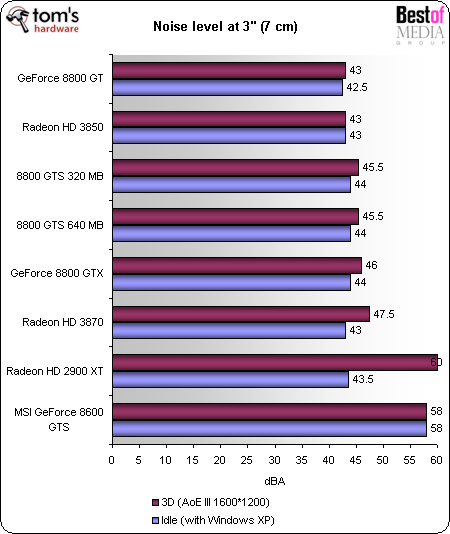AMD Radeon HD 3800: ATI Strikes Back
Noise, Overclocking
A little hesitation was allowed with regard to noise level when considering the cooling system chosen by AMD. Let's see the differences between each card thanks to a sonometer placed 2.8" (7 cm) away from the fan.
In the end, the situation remains very acceptable. The HD 3850 isn't noisier than the GeForce 8800 GT and remains inaudible at all times. On another note, the HD 3870 is only silent when idle; its fan accelerates in peak to become audible, but remains relatively discreet.
Temperature-wise, the RV670 of the HD 3870 displays 158°F (70°C) when idle and climbs up to 197.6°F (92°C) in peak. In absolute, those are elevated values, but they are often seen on graphic cards that traditionally have a much higher tolerance than CPUs. Therefore, these values don't surprise us.
Overclocking
The Radeon HD 3850 from AMD was quite playful, as we've been able to go from 670 MHz to 776 MHz for the RV670 (+16%) and from 833 MHz to 1050 MHz for the GDDR3 (+26%). The improvement in Age of Empires III in 1600 x 1200 does reach 16%, which is interesting given that the increase is higher on games that are bandwidth limited.
Concerning Sapphire's Radeon HD 3870, it's clear that AMD has pushed the RV670 higher and that it doesn't have a lot of margin anymore to increase it without seeing its yields collapse; we have thus reach stability's limit at 839 MHz from 775 originally (+8%). It's not the same for the memory; the GDDR4 was certified to run at 1200 MHz and was able to reach 1270 MHz on our sample, from an official clock of 1125 MHz as we've seen already, that's +13%. The increase reaches in the end 9%, which is only 2% less than the 8800 GT; we keep, however, the same proportions.
Get Tom's Hardware's best news and in-depth reviews, straight to your inbox.
